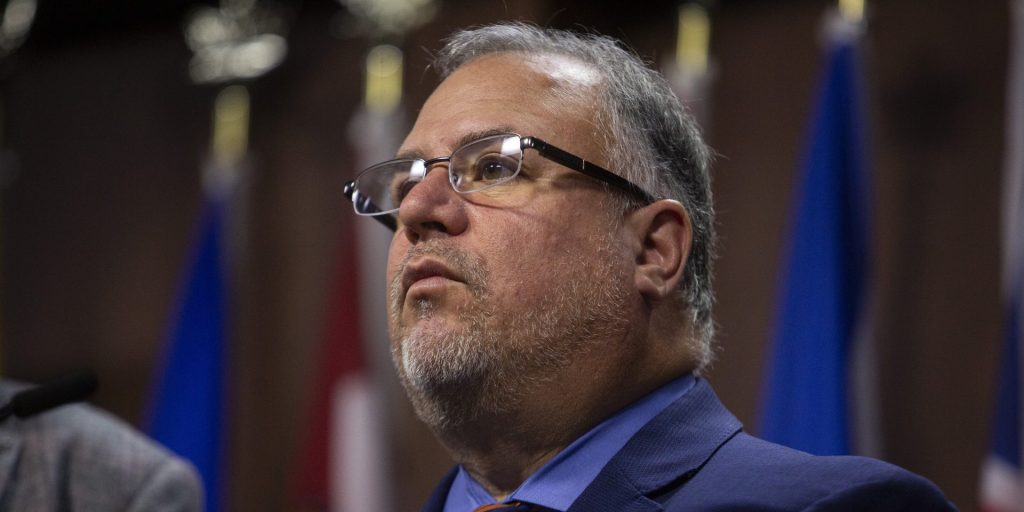Health minister won’t commit to tabling safe long-term care bill

Health Minister Marjorie Michel will not say whether she will move forward with the previous Liberal government’s promise to develop legislation to ensure safety in long-term care.
Health Canada’s 2025-26 departmental plan, released on June 17, does not mention any work to develop legislation—for which a consultation took place in 2023—nor does it refer to any funding related to the implementation of new standards for long-term care. However, both were cited as priorities in the department’s 2024-25 plan.
The Hill Times asked Michel’s (Papineau, Que.) office if her government would move ahead with legislation, and whether the Liberals have plans for any actions to ensure that living in long-term care is a safe way to age.
A response to those questions from Emilie Gauduchon-Campbell, Michel’s senior communications advisor, makes no mention of the legislation.
“Every senior in Canada deserves to live in dignity, safety and comfort, regardless of where they live. Our new government will work in partnership with provinces, territories, Indigenous peoples and all stakeholders to make sure we do right by Canadian seniors, their families and care workers,” wrote Gauduchon-Campbell in an emailed response on July 15.
The Canadian Association of Retired Canadians (CARP), which has advocated for this legislation, is disappointed by its absence as a priority from the most current departmental plan.

“Making sure that residents of long-term care homes are being cared for in the most dignified manner possible is important, and having a national standard and having a safe long-term care act provides a framework for all provinces to work under so that your postal code isn’t determining your quality of care,” said CARP president Anthony Quinn, referring to differing standards and levels of care between provinces.
Although the regulation of long-term care facilities is under provincial and territorial jurisdiction, problems with their infrastructure quality and challenges in delivering care were thrust into the national spotlight during the COVID-19 pandemic.
More than 80 per cent of all reported COVID-19 deaths in this country during the pandemic’s first wave between March 2020 and August 2020 occurred in long-term care, according to a 2021 report from Statistics Canada.
The virus spread so quickly in these homes during the pandemic’s first wave that the Ontario and Quebec governments asked the Trudeau government for military assistance to help with labour shortages in these facilities. Trudeau granted the requests.
A December 2021 report from the Canadian Institute for Health Information states that more than 14,000 residents and staff died in long-term care homes between March 1, 2020, and Aug. 15, 2021.
This high loss of life spurred the federal Liberals to promise in its 2021 election platform that it would develop a safe long-term care act “to ensure that seniors are guaranteed the care they deserve, no matter where they live.”
That promise was reinforced in March 2022 when this type of legislation was included as a condition of the Liberals’ supply-and-confidence agreement with the NDP.
Consultations took place between July 21, 2023, and Sept. 21, 2023. Gauduchon-Campbell’s statement said that Health Canada heard from more than 5,000 people in Canada, including health care organizations, academics, long-term care residents, staff and caregivers, provinces and territories, Indigenous partners, and others.
However, although the government conducted consultations, and the department released a “What we heard” report in August 2024, draft legislation was neither made public, nor was it tabled.
The supply-and-confidence agreement ended in September 2024, and Trudeau announced this past January he would step down as prime minister and Liberal leader following a party leadership race. Current Liberal leader Mark Carney (Nepean, Ont.) and the party won the federal election on April 28.
The Hill Times asked the health and seniors critics for the Conservative Party and NDP by email for a reaction to the omission of the safe long-term care promise from Health Canada’s 2025-26 plan.
Responding on behalf of the NDP, health critic Gord Johns (Courtenay—Alberni, B.C.) said in a July 16 statement that, “The Liberals promised long-term care workers, residents, and their families that they would improve funding for long-term and seniors care. Instead, they have failed—by underfunding health care and protecting the profits of large corporations and wealthy shareholders. New Democrats are calling on Mark Carney to change course: to put seniors’ lives ahead of corporate profits and to introduce a Safe Long-Term Care Act so we can finally deliver the care seniors deserve.”

The Hill Times did not receive a response from either Conservative health critic Dan Mazier (Riding Mountain, Man.) or the opposition seniors’ critic Anna Roberts (King—Vaughan, Ont.).
Jodi Hall, CEO of the Canadian Association for Long Term Care, told The Hill Times that her team noticed Health Canada’s 2025-26 plan did not include a reference to a safe long-term act. As for whether her organization supported the idea of legislation, she said they weren’t sure what position to take because of the limited information available about the previous government’s plan.
“I think, potentially, there could have been some opportunity there with perhaps greater alignment across the 13 different long-term care systems that we have across the country. And maybe through that, there could be some really great advancements with data, for example, and things of that nature,” Hall said.
But there were “more questions than answers” about a future bill, she added. “What does that mean from a jurisdiction point of view in Canada, and how would legislation like that work? So those are questions, I guess, that will remain unknown or unanswered because we never did see a draft piece of legislation in regards to that.”
Although the Trudeau government had asked the Standards Council of Canada, the Health Standards Organization, and the Canadian Standards Association Group to develop national standards for long-term care—and provided close to $850,000 for the project—the government also said it would not legislate national standards. Two sets of standards related to long-term care were released in January 2023.
The Liberal government set aside $3 billion over five years in Budget 2021 to help provinces and territories “in ensuring standards for long-term care are applied.”
Like the promise of safe long-term care legislation, the funding to provinces and territories for the use of standards was also not mentioned in Health Canada’s 2025-26 plan. Gauduchon-Campbell said by email that the Budget 2021 funding is included in bilateral Aging with Dignity agreements, and “these agreements are currently in place, with funding flowing to provinces and territories in line with their action plans set out in the agreements.”

Hall said her group is looking forward and concentrating on areas where the team can work with the current government’s priorities, which include developing a single Canadian economy and nation-building projects.
She said the renewal of long-term infrastructure, which has been a “long-standing need,” should be considered a nation-building project.
“There are tremendous challenges that long-term care homes face in accessing the appropriate capital that’s required to develop long-term care homes. The costs have certainly significantly increased across the country,” Hall said.
Hall said she would like to see the return of a program in which long-term care homes could access capital financing from the Canada Mortgage and Housing Corporation. That program, which facilitated a framework for long-term, low-interest and stable mortgages for these homes, wound down in the 1990s.
CARP’s Quinn said his team’s focus is on “improving the quality of care regardless of who the provider is,” adding that while some groups are concerned whether homes are publicly owned or privately owned, his organization believes that both private and public long-term care is needed to meet the demand for homes.
He said that the COVID-19 pandemic shone a public light on the previously private and more individual struggle to improve long-term care throughout the years.
Noting that residents typically live in long-term care for about 18 months before they die, Quinn said, “What has been happening in the past is a loved one goes into long-term care, the family members see that the conditions are not typically the most dignified … and then that person passes away, unfortunately, and then their fight kind of dies with the resident. The next resident moves in, and the fight starts all over again. So, that’s what was happening before COVID. It was just individuals trying to change the system.”
He added, “COVID opened up the eyes of the country. …That type of quality of care was a shame, I think, on Canada and we vowed to fix it. Certainly it’s going to take some time to meet all of those changes, but we can’t let up just because time has passed. We have to work as a society to fix it. I think we will fix it. I have faith.”
tsanci@hilltimes.com
The Hill Times






 LICENSING
LICENSING PODCAST
PODCAST ALERTS
ALERTS













